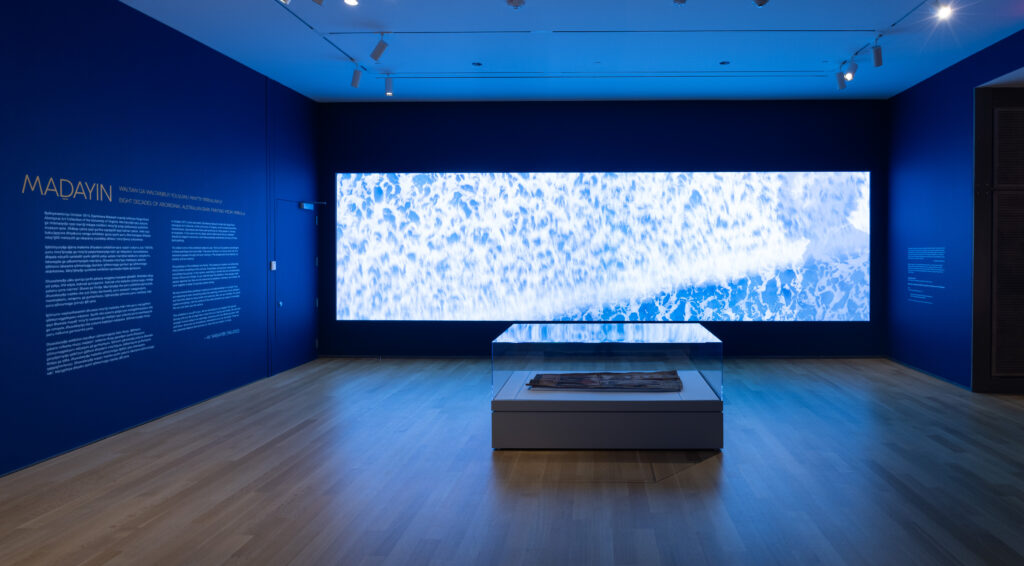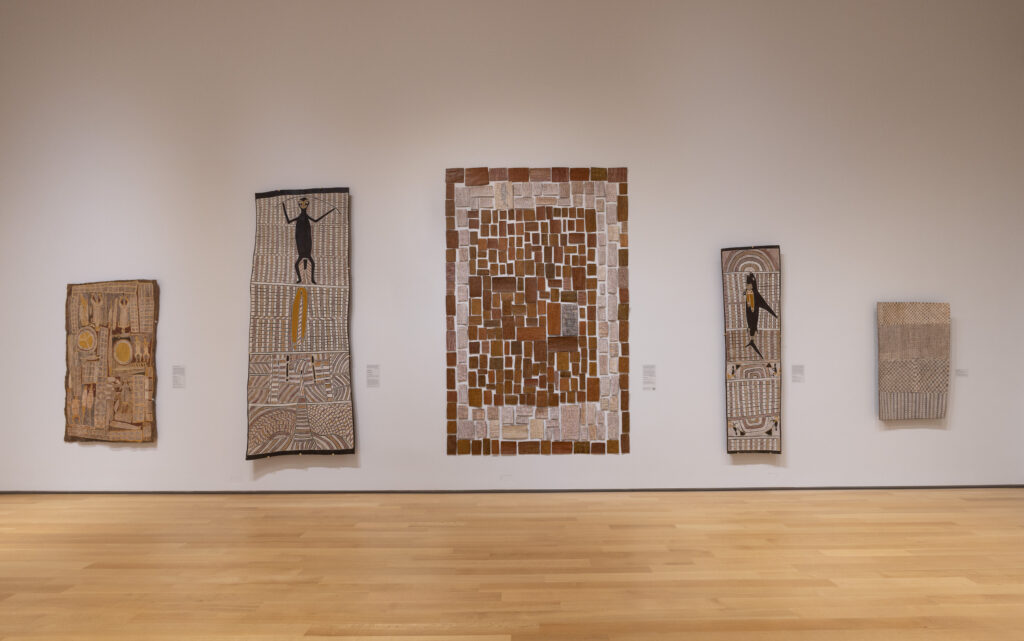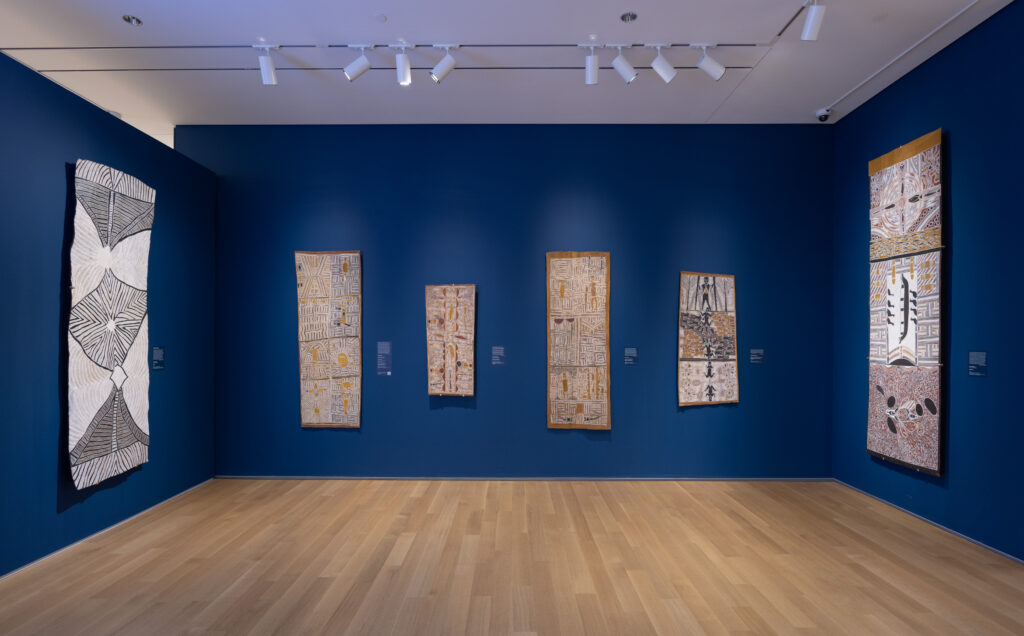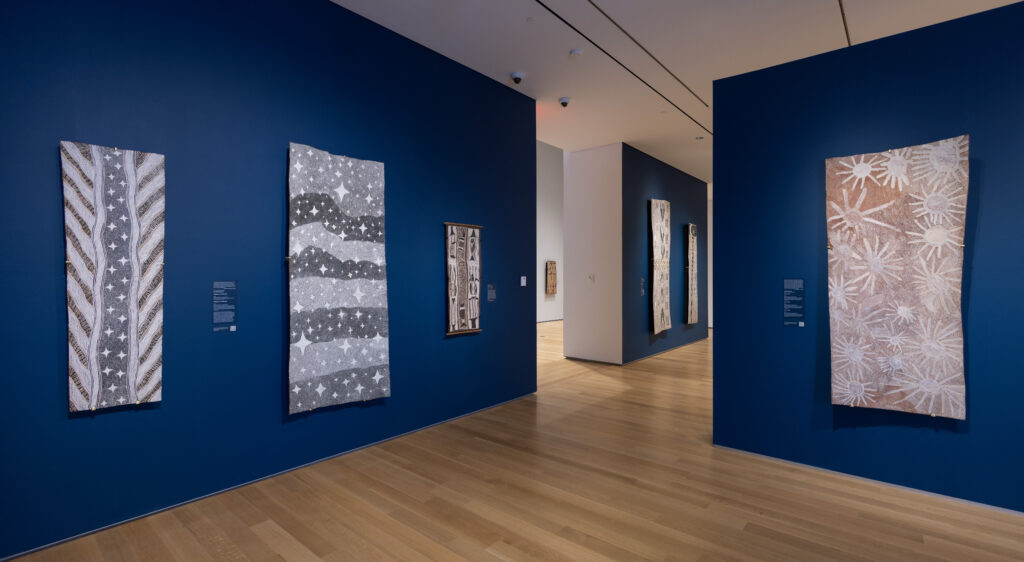
At the entrance to “Madayin: Eight Decades of Aboriginal Australian Bark Painting from Yirrkala,” at the Hood Museum of Art, a mural-sized film of crashing waves paired with a melodic song in Yolngu Matha (the Yirrkala language) creates an immersive experience. Voices echo above the rushing sounds of the waves and meld with rhythmic percussion. Against this backdrop, a gently illuminated bark painting is displayed in a vitrine in the center of the entry gallery.
In Yolngu parlance, madayin refers to that which is sacred and beautiful. “Madayin represents the coming together of sixteen Yolngu clans. … These songs are performed to signal the beginning of a ceremony, calling participants to a sanctified space,” a text adjacent to the video says. Yolngu refers to the clans who inhabit Yirrkala, a region in northern Australia.
The exhibition centers on Aboriginal bark painting, and is the result of a collaboration with the Kluge-Ruhe Aboriginal Art Collection of the University of Virginia, among other institutions. It’s a scholarly exhibition and there are copious wall texts describing, often in the artist’s own words, the meanings of the works and how they fit within the greater socio-political context of clan society.
The Hood’s engagement with Aboriginal Australian art began in 2004 when the museum mounted an exhibition titled “Dreaming of Country: Painting, Place, and People in Australia.” In the following decade, the museum acquired the collection of Will Owen (1952-2015) and Harvey M. Wagner (1931-2017) which sparked a series of exhibitions centered around Aboriginal art and culture. For “Madayin,” the museum tapped Djambawa Marawili, an artist and leader of the Madarrpa clan, to oversee the curatorial team.
As you scan the exhibition and read the materials, it becomes clear that the bark paintings are expressions of Yolngu cultural identity. They are more than artworks; they are modes of communication, governmental documents, historical records. The intricate patterns that cover them represent the ways in which every aspect of nature, personhood, political governance and family structure are interwoven.
The tradition of bark painting dates to about 1935, making it essentially a contemporary practice. However, the designs and the meanings are products of millennia of tradition and technique passed down among artisans through generations. As the supplementary material explains, the designs were originally “painted directly on the bodies of young men when they were initiated.” It’s important to keep in mind while viewing the works that they are more than “art for art’s sake.”
The paintings start with large sheets of bark stripped from eucalyptus trees. The strips of bark are then slowly warmed and flattened out and sanded to a smooth, workable surface. Earth pigments like ochre and white clay mixed with binder are traditionally used for the paint. One striking piece incorporates blue acrylic paint. It was the only example in the exhibition that employed synthetic pigment, and it made the piece look more “modern” than the earth-tone works.

Another piece that deviates from the standard format is a monumental wall piece composed of 299 small squares of bark arranged in a massive grid. In character, this work struck me more as a contemporary wall sculpture, something reminiscent of the minimalist works of Eva Hesse. This isn’t a stretch, considering the long history of so-called “ethnographic art” being appropriated by Western artists.
While most of the work is abstract, without recognizable imagery, there are examples that depict human, animal and plant forms. These representations are wonderfully stylized and expressive amidst the labyrinthine networks of lines and shapes that adorn the surfaces. Videos throughout the exhibition show men in traditional dress performing dance and song. These echo the contents of the bark paintings and remind viewers of the multiple dimensions that these works convey. The Yolngu designs are powerful and they evoke a feeling of unity, of oneness, that is rarely captured in visual art.
Eric Sutphin is a freelance writer. He lives in Plainfield.


